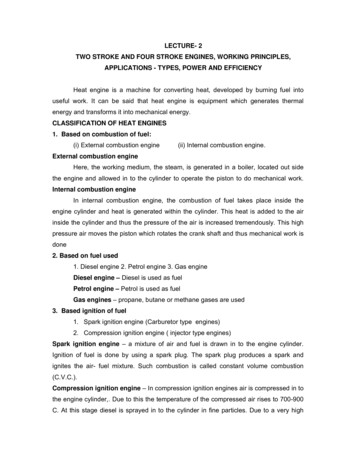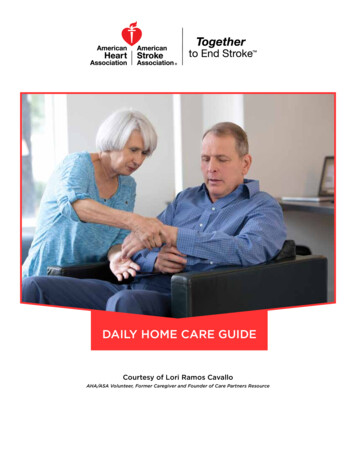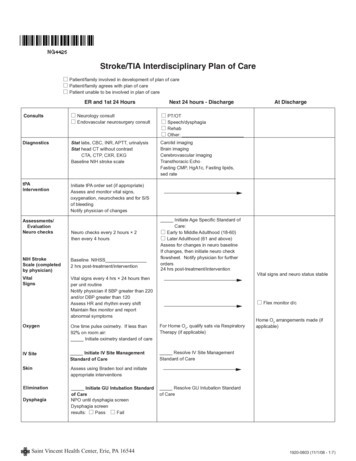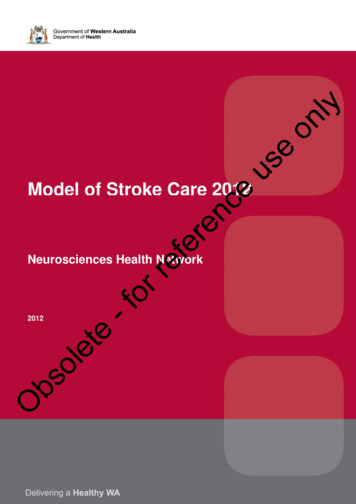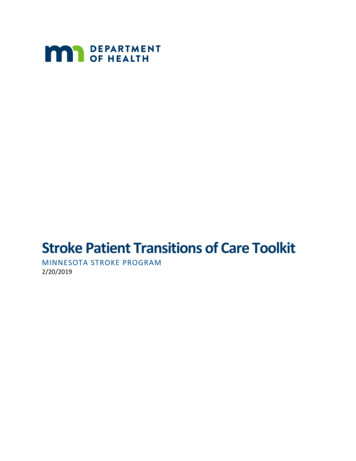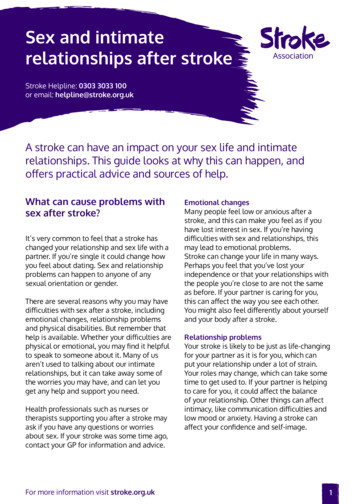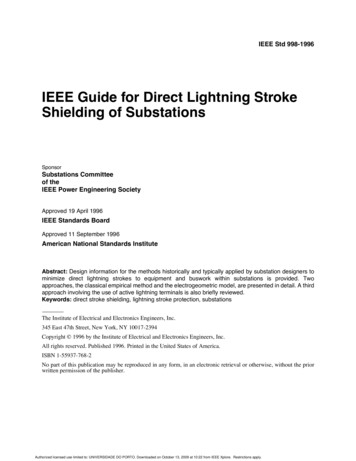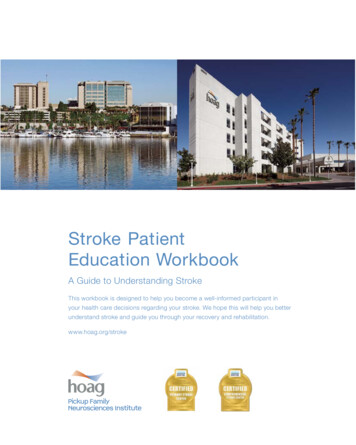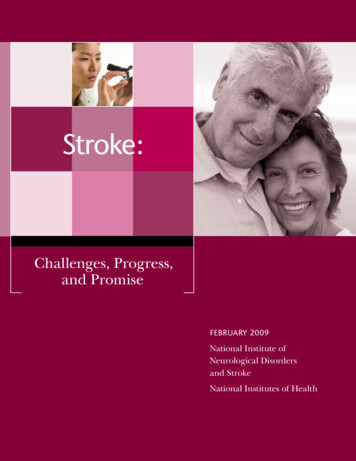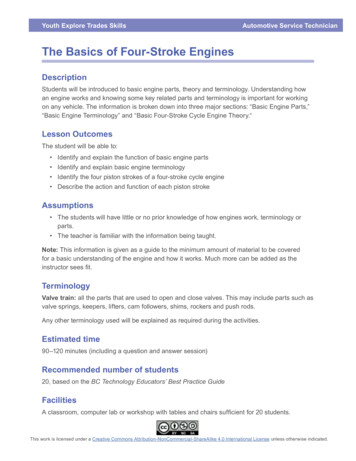
Transcription
Youth Explore Trades SkillsAutomotive Service TechnicianThe Basics of Four-Stroke EnginesDescriptionStudents will be introduced to basic engine parts, theory and terminology. Understanding howan engine works and knowing some key related parts and terminology is important for workingon any vehicle. The information is broken down into three major sections: “Basic Engine Parts,”“Basic Engine Terminology” and “Basic Four-Stroke Cycle Engine Theory.“Lesson OutcomesThe student will be able to: Identify and explain the function of basic engine parts Identify and explain basic engine terminology Identify the four piston strokes of a four-stroke cycle engine Describe the action and function of each piston strokeAssumptions The students will have little or no prior knowledge of how engines work, terminology orparts. The teacher is familiar with the information being taught.Note: This information is given as a guide to the minimum amount of material to be coveredfor a basic understanding of the engine and how it works. Much more can be added as theinstructor sees fit.TerminologyValve train: all the parts that are used to open and close valves. This may include parts such asvalve springs, keepers, lifters, cam followers, shims, rockers and push rods.Any other terminology used will be explained as required during the activities.Estimated time90–120 minutes (including a question and answer session)Recommended number of students20, based on the BC Technology Educators’ Best Practice GuideFacilitiesA classroom, computer lab or workshop with tables and chairs sufficient for 20 students.This work is licensed under a Creative Commons Attribution-NonCommercial-ShareAlike 4.0 International License unless otherwise indicated.
The Basics of Four-Stroke EnginesAutomotive Service TechnicianMaterials Basic engine parts to show as examples, or images of them. A wide variety would be best(1, 4, 6 and 8 cylinders) Engine cutawayResourcesFour Stroke EngineAnimation of four-stroke engine in motion. Other depicted engines can be found on the le Engine: .htmHow Car Engines Workwww.howstuffworks.com/engine.htmWorld’s Largest and Most Powerful Diesel EngineGeneral interest—description of the largest two-stroke diesel engine, designed for use incontainer st-and-most-powerful-diesel-engine/Print ResourcesStockel, Martin. Auto Mechanics Fundamentals. Goodheart-Wilcox Co., 1990.McGraw-Hill Education (author). Automotive Excellence, Volume 1 (3rd Edition). Glencoe/McGraw-Hill, 2006.2Youth Explore Trades Skills
Automotive Service TechnicianThe Basics of Four-Stroke EnginesActivityThis information can be presented in many different ways and formats: straight theory lessons,worksheets, computer research assignments or textbook assignments. This information ismeant only to be the essential basics to build a foundation on how an engine functions.1. Basic Engine PartsEngine BlockThe engine block is the foundation and centre of the engine. Blocks come in many differentsizes, shapes and styles.The engine block holds the cylinder, the crankshaft, connecting rods (“con rods”) and pistons.The large round holes in the block, called cylinders, are where the pistons slide up and down.Figure 1—Cylinder block with head attachedYouth Explore Trades Skills3
The Basics of Four-Stroke EnginesAutomotive Service TechnicianPistonA piston slides up and down a cylinder and pushes the crankshaft around. The piston connectsto the crankshaft via the connecting rods.Figure 2—PistonFigure 3—Piston with connecting rod attachedPiston RingsEach piston has two compression rings and one oil control ring to help seal the piston in thecylinder.First compressionring grooveSecond compressionring grooveOil controlring grooveSkirtFigure 4—A piston with two compression rings and one oil control ringFigure 5—Piston rings (compression rings and oil control ring, left to right)4Youth Explore Trades Skills
Automotive Service TechnicianThe Basics of Four-Stroke EnginesConnecting RodsConnecting rods connect the pistons to the crank. They utilize an I-beam construction forstrength.Figure 6—Connecting rodCrankshaftThe crankshaft is bolted to the bottom of the engine block through bearings so it can rotatefreely. It is sometimes referred to as the crank. The crankshaft converts the vertical motion ofthe pistons and connecting rods to rotational motion. One end of the crankshaft is connectedto a flywheel that transfers the engine power to the wheels through a transmission (manual orautomatic).Figure 7—Crankshaft with pistons and connecting rodsattachedYouth Explore Trades SkillsFigure 8—Crankshaft of a 1-cylinder engine withconnecting rod attached5
The Basics of Four-Stroke EnginesAutomotive Service TechnicianCylinder HeadThe cylinder head is bolted to the top of the cylinder block. It serves as a cover for the cylindersand pistons. The cylinder head helps to create the top part of the combustion chamber. Anengine “breathes” through the cylinder head. It lets an air/gas mixture into the engine andexhaust out of the engine. The valves and valve train control the breathing of the engine byopening and closing the valves at the appropriate time.Figure 9—Top view of cylinder head with camshafts attachedFigure 10—Bottom view of cylinder head showing where the valves sitNote: This has four valves per cylinder (two intake and two exhaust).6Youth Explore Trades Skills
Automotive Service TechnicianThe Basics of Four-Stroke EnginesFigure 11—Cylinder head being attached to engine blockValvesValves can be divided into two groups: Intake valves control the flow of the air/gas mixture into the engine. Exhaust valves control the flow of exhaust out of the engine.Figure 12—Exhaust and intake valvesYouth Explore Trades SkillsFigure 13—Valve7
The Basics of Four-Stroke EnginesAutomotive Service TechnicianCamshaftThe camshaft controls the opening and closing of the valves. There is one lobe on the camshaftfor each valve in the engine. Camshaft lobe design dictates three things: How far the valve opens How fast the valve opens How long the valve opensDepending on the engine type, the camshaft can be located either in the engine block or overthe head (OHC) or double OHC (DOHC).Figure 14—Cam lobe profile showing the opening and closing anglesFigure 15—Camshaft8Youth Explore Trades Skills
Automotive Service TechnicianThe Basics of Four-Stroke EnginesFigure 16—In-the-block camshaftFigure 17—Camshaft located over the headLifters (Tapetts)Lifters are the link between the cam and valves. They are so named because they actually lift asthe cam lobe rotates and open the valves. There are two basic types of lifters: The hydraulic lifter The solid lifterYouth Explore Trades Skills9
The Basics of Four-Stroke EnginesAutomotive Service TechnicianTiming Chain/Belt/GearsThese parts are used in different combinations and configurations to connect the crankshaftto the camshaft. They keep the valves’ opening and closing timed with the piston movement.Timing belts should be replaced every 100,000 km or every five years.Valve TrainThe valve train includes all the parts that are used to open and close valves. This may includeparts like valve springs, keepers, lifters, cam followers, shims, rockers and push rods.Figure 18—Diagram of an engine with overhead camshafts, demonstrating valve train componentsFlywheelThe flywheel attaches to the crankshaft, and uses its momentum to power the engine throughthe three non-power strokes (intake, compression and exhaust). Because an 8-cylinder car hasmore power strokes than a 4-cylinder car, the flywheel will be smaller and lighter as there is lessneed for the momentum carry capabilities. Flywheels are used in standard transmissions. Flexplates are used in automatic transmissions.Flywheels and flexplates have a ring gear for the starter.10Youth Explore Trades Skills
Automotive Service TechnicianThe Basics of Four-Stroke Engines2. Basic Engine TerminologyBore: the distance across the cylinder (or the diameter).Bottom dead centre (BDC): the lowest point in the cylinder that the piston reaches.Combustion chamber: the space left at the top of the cylinder when the piston is at top deadcentre (TDC). This also includes any space in the cylinder head.Compression: the squishing or squeezing of the air/fuel mixture from BDC to TDC. The morethe mixture is compressed, the more power it can produce.Compression ratio: the difference as expressed through a ratio of the space left in the cylinderwhen the piston is at TDC versus BDC. For example, 8:1 means that the space when the pistonis at BDC is 8 times bigger than when the piston is at TDC.Cubic inch displacement (CID): the engine size. For example, Chevy 350 (cubic inches),Mustang 5.0 (cubic litres) or Honda 1800 cc (cubic centimetres). Even though 5.0 L and 1800 ccare metric measurements, they are often referred to as the CID of an engine.CID is a mathematical calculation that takes into account the bore and stroke of the cylindertimes the number of cylinders in the engine. It basically measures how much volume or air acylinder can displace or push out from BDC to TDC.Engine types: engines can be classified in many different ways, but three basic engine typeslikely to be encountered in an automotive shop are: Four-stroke cycle engine—takes four stokes of the piston to complete a cycle Two-stroke cycle engine—takes two strokes of the piston to complete a cycle Diesel—(two or four stroke) uses heat of compression rather than a spark plug to ignite thefuel that is directly injected into the cylinderEach of these engines can come in several different configurations.Four-stroke cycle: four movements of the piston equals one cycle.Stroke: the distance the piston travels from TDC to BDC or from BDC to TDC.Top dead centre (TDC): the highest point in the cylinder that the piston reaches.Youth Explore Trades Skills11
The Basics of Four-Stroke EnginesAutomotive Service Technician3. Basic Four-Stroke Engine TheoryRegardless of its design, an engine needs four things in order to deliver a substantial amount ofuseful energy or work:1. Air2. Fuel to burn3. Ignition source to ignite the fuel4. Compression of the air/fuel mixture to maximize the power potential of the fuelTake away any of these items and an engine will not run. Therefore all engine designs are basedon allowing these key factors to work in harmony for a smooth, powerful and efficiently runningengine.Example: You could pour out some gas on a small plate and light it on fire. Although it wouldproduce some light and heat, it would not be a great source of power. However, taking that sameplate of gas and compressing the air around it by placing a bowl over it and igniting the gaswould produce enough power to blow the bowl off the plate. This is the basics of how an engineworks.The Four-Stroke CycleNickolaus Otto is credited with building the first four-stroke cycle engine in 1867, considered thebasis of our modern engines. In his honour it is often called the Otto cycle engine.1. Intake stroke The piston moves from TDC to BDC (down). The intake valve is open. The exhaust valve is closed. The piston creates a suction (vacuum) and air and fuel are sucked into the cylinder.Intake valveopenExhaust valveclosedTop dead centre(TDC)StrokeBottom dead centre(BDC)Figure 19—Intake stroke12Youth Explore Trades Skills
Automotive Service TechnicianThe Basics of Four-Stroke Engines2. Compression stroke The piston moves from BDC to TDC (up). Both valves are closed. The piston compresses the air and fuel mixture.Intake valveclosedExhaust valveclosedTop dead centre(TDC)StrokeBottom dead centre(BDC)Figure 20—Compression stroke3. Power stroke The piston moves from TDC to BDC (down). Both valves are closed. The spark plug fires. The fuel mixture burns rapidly. This expanding heated mixture forces the piston down.Intake valveclosedExhaust valveclosedTop dead centre(TDC)StrokeBottom dead centre(BDC)Figure 21—Power strokeYouth Explore Trades Skills13
The Basics of Four-Stroke EnginesAutomotive Service Technician4. Exhaust stroke Piston moves from BDC to TDC (up). The intake valve is closed. The exhaust valve is open. The piston pushes the exhaust out.Intake valveclosedExhaust valveopenTop dead centre(TDC)StrokeBottom dead centre(TDC)Figure 22—Exhaust strokeThe cycle repeats itself.The four-stroke cycle is presented in chart form below. Note the following: The piston direction has a distinct pattern. The intake valve is only open during the intake stroke. The exhaust valve is only open during the exhaust stroke.IntakeCompressionPowerExhaustPiston DirectionDownUpDownUpIntake ValveOpenClosedClosedClosedExhaust ValveClosedClosedClosedOpenMixture ActionSucked InBeing SquishedIgnitedPushed OutRemember ICPE: intake, compression, power, exhaust.The cycle repeats itself. This order cannot change!14Youth Explore Trades Skills
Automotive Service Technician The Basics of Four-Stroke Engines Youth Explore Trades Skills 5 Connecting Rods Connecting rods connect the pistons to the crank. They utilize an I-beam construction for strength. Figure 6—Connecting rod Crankshaft The crankshaft is bolted to the bottom of t
